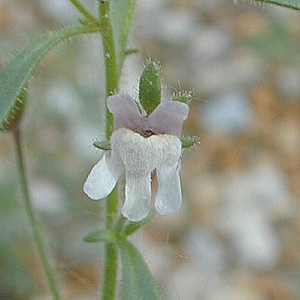(chaeorrhinum minus) Scrophulariaceae
No other photos at this time.
 Roots: The roots are tap roots, but
are not very long and they often have other roots branching off of them
(1).
Roots: The roots are tap roots, but
are not very long and they often have other roots branching off of them
(1).
Stems/Leaves: The stem is about 4 inches to 12 inches tall, branching often. The stem is narrow and round and covered with white hairs. The leaves are about 1 inch long and about 1/6 of an inch wide. The leaves are also ciliate and smooth The leaves often start to grow at the bottom of the plant and grow up-ward from there (2).
Flower: The flower consist of five sepals, five petals, and four stamens in unequal pairs. The stigma is often "head-shaped." The flower has an arching two lobed upper lip, and a three lobed lower lip. The outer flower and overall color is purple. The overall flower shape resembles the toadflax and the full sized snap dragon. The flower color can range from a lilac and white with a yellow throat to mainly white with a purple stipe through out the lower lip (3,9,10).
Fruits and Seeds: The fruit is a capsule, and each capsule produces 40 to 60 dark brown seeds (4).
Methods of reproduction: When the flower bud seeds fall out after they are ripened the wind carries them off until the seed falls (5).
Life style/habits and life duration: The dwarf snap dragon is an annul herb and they are often found around rail road tracks and highways. It does not tolerate shade and lives for about 5 years before it is out competed by near-by vegitation (6).
Environment favorable for infestation: Dwarf snapdragons are often found along rail road tracks, roads, and dry creek beds. They can also be found in dry gravely soil beds (6).
Methods of control:
Non Chemical: you are able to pull these weeds out of the ground or you can mow them over with your lawn mower, they have a very shallow tap root, so they are easy to pull (7).
Chemical: the plants are easy to spray (8) .
1) http://vtgcrec.ifas.ufl.edu/pages/Snapdragon-Short-Thumb-01-02.htm
2) http://www.ct-botanical-society.org/galleries/chaenorhinumminu.htm
3) http://vtgcrec.ifas.ufl.edu/pages/Snapdragon-Short-Thumb-01-02.htm
4) http://www.nwcb.wa.gov/weed_info/Written_findings/Chaenorrhinum_minus.html
5) http://www.wssa.net/photo&info/weedstoday_info/snapdragon.htm
6) http://davesgarden.com/pf/go/56877/index.html
7) http://www.co.stevens.wa.us/weedboard/other%20weeds/dwarfsnap.htm
8) http://www.illinoiswildflowers.info/weeds/plants/dw_snapdragon.htm
9) http://www.omafra.gov.on.ca/english/crops/hort/news/hortmatt/2003/19hrt03a7.htm
10) http://www.delawarewildflowers.org/0461.html
Bibliography:
1) Arnold, R. M. 1991. Dwarf Snapdragon -The Railroad Weed. Weed Technology. Vol. 5:467-8.
2) Arnold, R. M. 1982. Floral Biology of Chaenorrhinum minus (Scrophulariaceae) a Self-compatible Annual. The American Midland Naturalist. 108(2). Pp. 317-324.
3) McGregor, R. L. (Editor) 1986. Flora of the Great Plains. University Press of Kansas. P. 762.
4) Muenscher, W.C. 1980. Weeds. Cornell University Press. Ithaca and London. Pp. 391-2.
5) Roche’ C. 1991. Dwarf snapdragon. Pacific Northwest Extension Publication. WSU Cooperative Extension. PNW378.
mtwow.org HOME BACK TO NEW WEED INVADERS
By: Tyler Smith, 2-23-06.